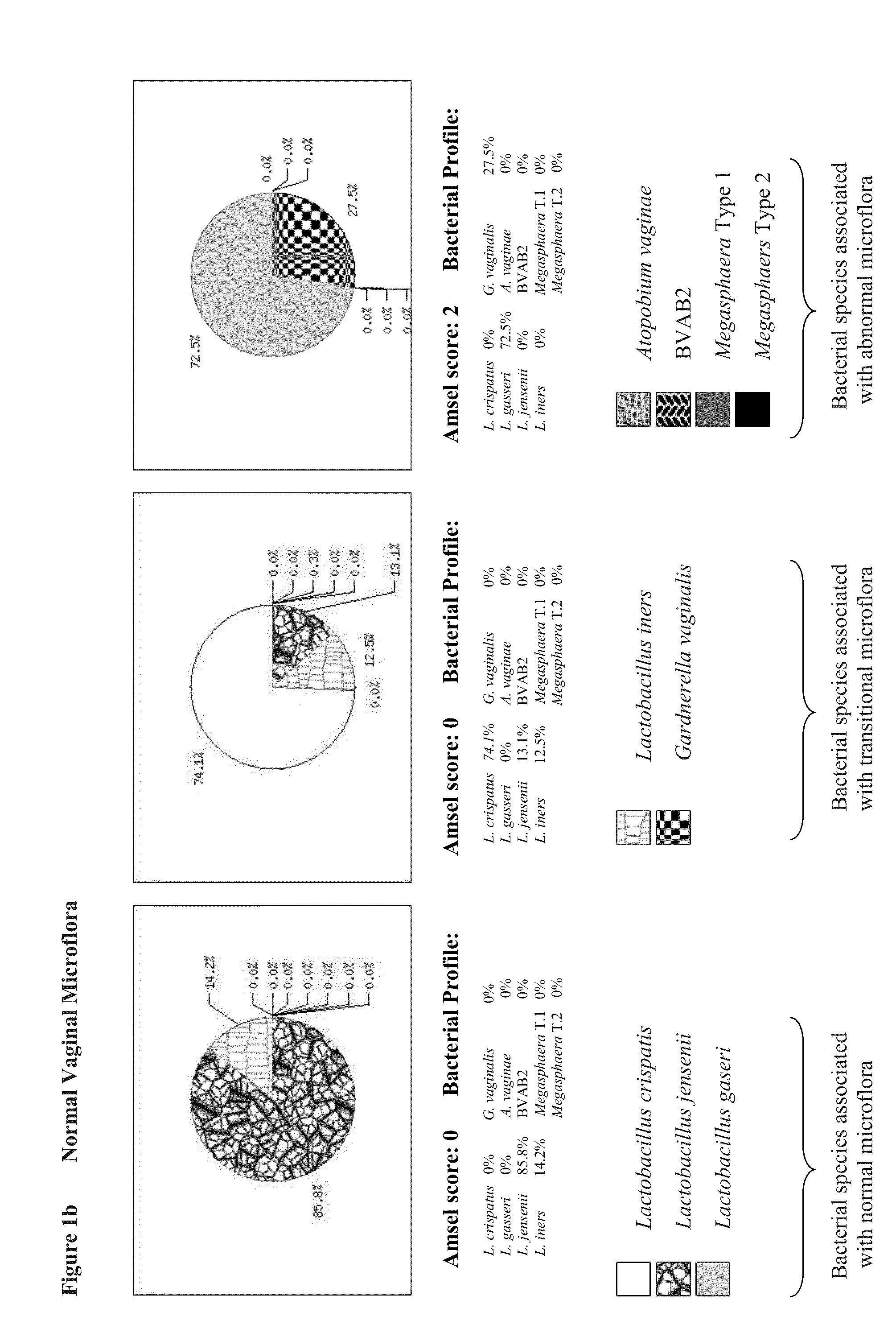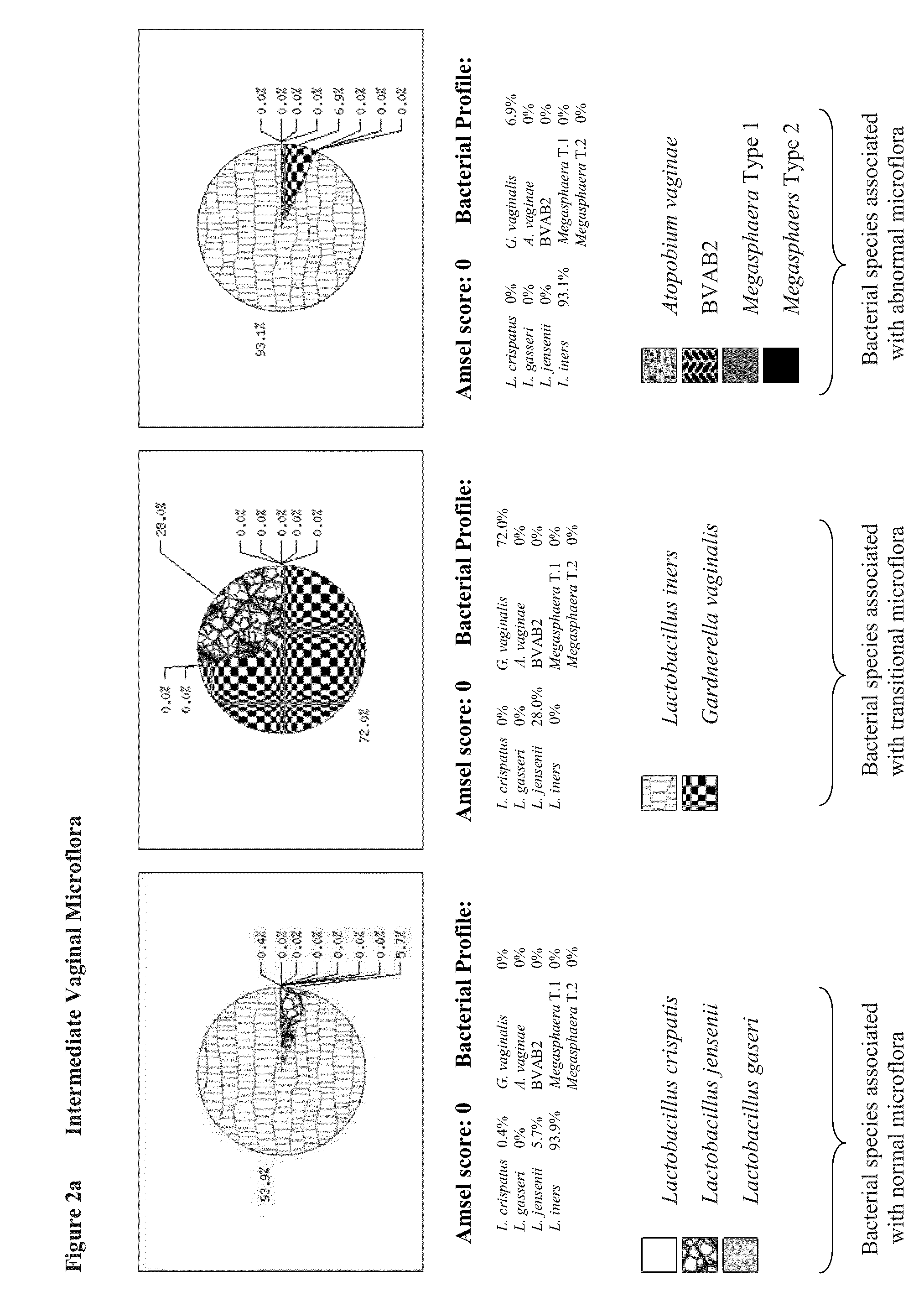Quantitation and profiling of vaginal microflora
- Summary
- Abstract
- Description
- Claims
- Application Information
AI Technical Summary
Benefits of technology
Problems solved by technology
Method used
Image
Examples
example 1
Development and Validation of Respective qPCR Assay
[0094]a) Selection of Specific Microflora Species for qPCR Assays
[0095]We developed respective qPCR assays to quantify microflora that are present in vagina. We selected specific bacterial species in our study that is believed to represent a global vaginal microflora. This includes four (4) Lactobacillus species (namely, Lactobacillus crispatus, Lactobacillus gasseri, Lactobacillus jensenii, and Lactobacillus iners), Gardnerella vaginalis, Atopobium vaginae, Megasphaera Type 1 and Megasphaera Type 2, and BVAB2.
[0096]We established specific qPCR assays to quantify these selected microbial species present in vaginal samples. All DNA primers and fluorescently-labeled probes were designed in defined annealing temperature ranges to allow efficient amplification at the same thermal conditions and PCR chemical composition. Table 1 summarizes the general thermal conditions for the respective qPCR assays.
TABLE 1Thermal Conditions for qPCRsSt...
example 2
Clinical Study—Assessment of Vaginal Microflora by The Developed qPCR Assays
[0111]We obtained a total of 186 vaginal swabs from females pursuant to our clinical study. All 186 swabs were tested positive for human DNA because they all contain human GAPDH gene. Out of the 186 cervico-vaginal samples, 17 of them failed to produce any qPCR signals. They were therefore considered to reflect an absence of vaginal microflora (i.e., lack of microbial species) under the present study. The other 169 cervico-vaginal samples were confirmed to test positive for qPCR signals, at least with respect to a microbial species out of the selected vaginal microflora (i.e., Lactobacillus crispatus, Lactobacillus gasseria, Lactobacillus jensenii, Lactobacillus iners, Gardnerella vaginalis, Atopobium vaginae, Megasphaera Type 1, Megasphaera Type 2 and BVAB2).
[0112]We used the qualitative qPCR results (i.e., the presence and absence) of these selected microbial species in determining the association between ...
example 3
Profiling of Vaginal Microflora Per Individual
[0123]Quantitative analysis of bacterial loads demonstrated their high variability in the range between 101 and 106 genomic copies per reaction in both normal and BV specimens. However median concentrations of bacterial DNAs in both groups were similar for all tested bacteria: 104-105 genomic copies per PCR depending on target microorganism (FIG. 1). Concentration of human chromosomal DNA was variable as well in the range between 101 and 106 genomic copies per reaction with the median concentration of 105 genomic copies similar in both normal and BV qPCRs.
[0124]DNA concentrations for each of nine (9) pathogens determined by qPCRs were combined together generating pie chart graphs that represented the relative abundance of bacterial species in proportion to one another in each of the samples. Based on bacterial composition all of the samples were divided between three major groups presumably representing three states of vaginal microflora...
PUM
| Property | Measurement | Unit |
|---|---|---|
| Fraction | aaaaa | aaaaa |
Abstract
Description
Claims
Application Information
 Login to View More
Login to View More - R&D
- Intellectual Property
- Life Sciences
- Materials
- Tech Scout
- Unparalleled Data Quality
- Higher Quality Content
- 60% Fewer Hallucinations
Browse by: Latest US Patents, China's latest patents, Technical Efficacy Thesaurus, Application Domain, Technology Topic, Popular Technical Reports.
© 2025 PatSnap. All rights reserved.Legal|Privacy policy|Modern Slavery Act Transparency Statement|Sitemap|About US| Contact US: help@patsnap.com



